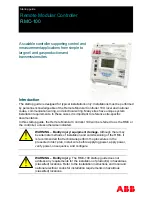
2105551-001 rev. AC |
11
4.4.3 Pulse input pinouts
Table 5 and Figure 5 identify the PI pinouts.
Table 5: Pulse input pinouts
Input PIN Description
1
1
INP - Pulse input 1
2 GND
-
Ground
2
1
INP - Pulse input 2
2 GND
-
Ground
PI
1
2
1
2
1
2
Figure 5: Pulse input pinouts
4.4.4 Digital input and output pinouts
Table 6 and Figure 6 identify the DI/DO pinouts.
Table 6: Digital I/O pinouts
DI/DO PIN Description
DI/DO PIN Description
1
1 SIG
−
Signal DI/DO 1
4
1 SIG
−
Signal DI/DO 4
2 GND
−
ground 2
GND
−
ground
2
1 SIG
−
Signal DI/DO 2
5
1 SIG
−
Signal DI/DO 5
2 GND
−
ground 2
GND
−
ground
3
1 SIG
−
Signal DI/DO 3
6
1 SIG
−
Signal DI/DO 6
2 GND
−
ground 2
GND
−
ground
DI/DO
1
2
3
4
5
6
1
2
1
2
1
2
1
2
1
2
1
2
Figure 6: Digital I/O pinouts
4.5 Connecting TFIO modules
The RMC has two TFIO ports. Each TFIO port requires a TFIO installation kit which
includes the cable to connect the TFIO modules to the RMC. For additional
information, refer to the
TFIO Module User Manual
.
CAUTION – Equipment damage.
When the TFIO interface is disabled,
the module(s) remain powered. Remove the power from the RMC
before connecting or disconnecting additional TFIO module(s) or TFIO
cable. Failure to power down the RMC may result in damage to the
module(s).


























